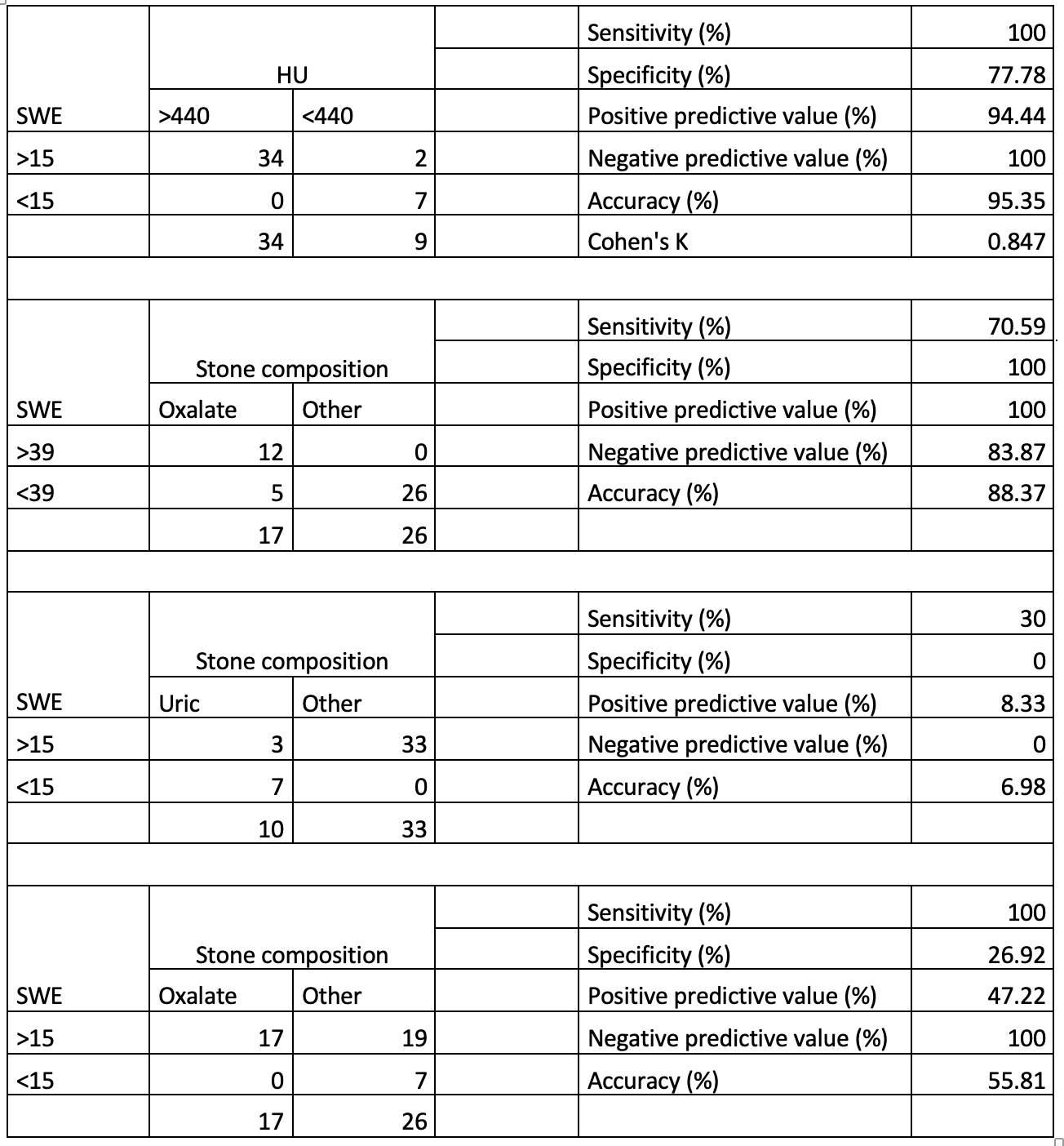Back
Poster, Podium & Video Sessions
Podium
PD50: Stone Disease: Epidemiology & Evaluation II
PD50-09: Clinical Implications of Ultrasound Shear Wave Elastography of Urinary Stones in Patient Candidate for Ureteroscopy
Sunday, May 15, 2022
4:50 PM – 5:00 PM
Location: Room 255
Enrico De Marzo*, Chiara Lonati, Stefania Zamboni, Brescia, Italy, Giuseppe Pezzotti, Desenzano, Italy, Claudio Simeone, Brescia, Italy
- ED
Podium Presenter(s)
Introduction: Noncontrast computed tomography has revolutionized the evaluation of renal stone disease, having a good concordance between HU and stone composition.Elastography-based imaging techniques take advantage of changed soft tissue elasticity to yield qualitative and quantitative information with low costs.Measurements are acquired in specialized imaging modes that can detect tissue stiffness in response to an applied mechanical force-Shear waves-SWE.We aimed to evaluate the association between HU,Ultrasound Elastography,and the composition of urinary stones in patients who underwent a ureteroscopy.
Methods: We retrieved data of 43 patients who underwent ureteroscopy for urinary stones between 01/2020 and 06/2021 from our Institutional prospectively maintained dataset.First, we expressed the degree of agreement between Shear wave elastography density <15kPa and HU <440 as concordance,which was defined as the ability of SWE to predict non XR-opaque stones then confirmed as HU at the CT scan with the Cohen’s kappa coefficient value. Discordant cases included those in which SWE density <15kPa indicated non XR-opaque stones then not confirmed at HU.Secondly, we expressed the degree of agreement between Shear wave elastography density>39kPa and calcium oxalate as concordance which was defined as the ability of SWE to predict the composition of the stone being calcium oxalate.Discordant cases included those in which SWE>39kPa indicated a calcium oxalate stone not confirmed at the stone composition analysis.
Results: The overall concordance in detecting non XR-opaque stones was defined as good concordance (coefficient: 0.87).Accuracy in predicting calcium oxalate stones is high with SWE>39 (88.37%).Accuracy is lower in predicting uric acid stones with SWE>15 and higher in predicting calcium oxalate stones (respectively 6.98% vs 55.81%)(Table 1)
Conclusions: SWE in urology has shown encouraging results in detecting urinary kidney stones and in defining their composition, potentially providing a low-cost, non-invasive imaging alternative to NCCT. Further studies are necessary in order to define all the possible applications of this technique, and to select the patients that might benefit from this diagnostic method.
Source of Funding: None

Methods: We retrieved data of 43 patients who underwent ureteroscopy for urinary stones between 01/2020 and 06/2021 from our Institutional prospectively maintained dataset.First, we expressed the degree of agreement between Shear wave elastography density <15kPa and HU <440 as concordance,which was defined as the ability of SWE to predict non XR-opaque stones then confirmed as HU at the CT scan with the Cohen’s kappa coefficient value. Discordant cases included those in which SWE density <15kPa indicated non XR-opaque stones then not confirmed at HU.Secondly, we expressed the degree of agreement between Shear wave elastography density>39kPa and calcium oxalate as concordance which was defined as the ability of SWE to predict the composition of the stone being calcium oxalate.Discordant cases included those in which SWE>39kPa indicated a calcium oxalate stone not confirmed at the stone composition analysis.
Results: The overall concordance in detecting non XR-opaque stones was defined as good concordance (coefficient: 0.87).Accuracy in predicting calcium oxalate stones is high with SWE>39 (88.37%).Accuracy is lower in predicting uric acid stones with SWE>15 and higher in predicting calcium oxalate stones (respectively 6.98% vs 55.81%)(Table 1)
Conclusions: SWE in urology has shown encouraging results in detecting urinary kidney stones and in defining their composition, potentially providing a low-cost, non-invasive imaging alternative to NCCT. Further studies are necessary in order to define all the possible applications of this technique, and to select the patients that might benefit from this diagnostic method.
Source of Funding: None


.jpg)
.jpg)